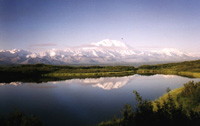 Photo.
Photo. Mt.
Kinley, the highest mountain in Alaska (the photo was taken in the summer time).
According to the Official Site of the Last Great Race (www.iditarod.com
), it has been called the "Last Great Race on
Earth" and it has won worldwide acclaim and interest.
German, Spanish, British, Japanese and American film crews have covered the event.
Journalists from outdoor magazines, adventure magazines, newspapers and wire
services go to Anchorage and Nome to cover the big event.
The participations start at Anchorage, the capital in Alaska, located in
south central part of Alaska. Anchorage is a city of over 250,000 people,
with street lights, freeways and traffic. From here the race goes to
Nome on the western Bering Sea coast. Each team have 12 to 16 dogs and
their musher cover over 1150 miles in 10 to 17 days.
As the Official Site of the Last Great Race see it: It's not just a dog sled
race, it's a race in which unique men and woman compete. Mushers enter from all
walks of life. Fishermen, lawyers, doctors, miners, artists, natives, Canadians,
Swiss, French and others; men and women each with their own story, each with
their own reasons for going the distance. It's a race organized and run
primarily by volunteers, thousands of volunteers, men and women, students and
village residents.
The race is also for commemoration. The race pits man and animal against
nature, against wild Alaska at her best and as each mile is covered, a tribute
to Alaska's past is issued. The Iditarod is actual a commemoration of dramatic
events in the past. In 1925, part of the Iditarod Trail became a life saving
highway for epidemic-stricken Nome. Diphtheria threatened and serum had to be
brought in. All via dog sled: heroes were made, legends were born.
The Last Great Race on Earth, Iditarod, is for people who like real big
challenges, and it`s definitely the spirit of Alaska!
Stein Morten Lund, 12 March 2004
Additional information
For more information
about the race and update, click on the link www.iditarod.com
